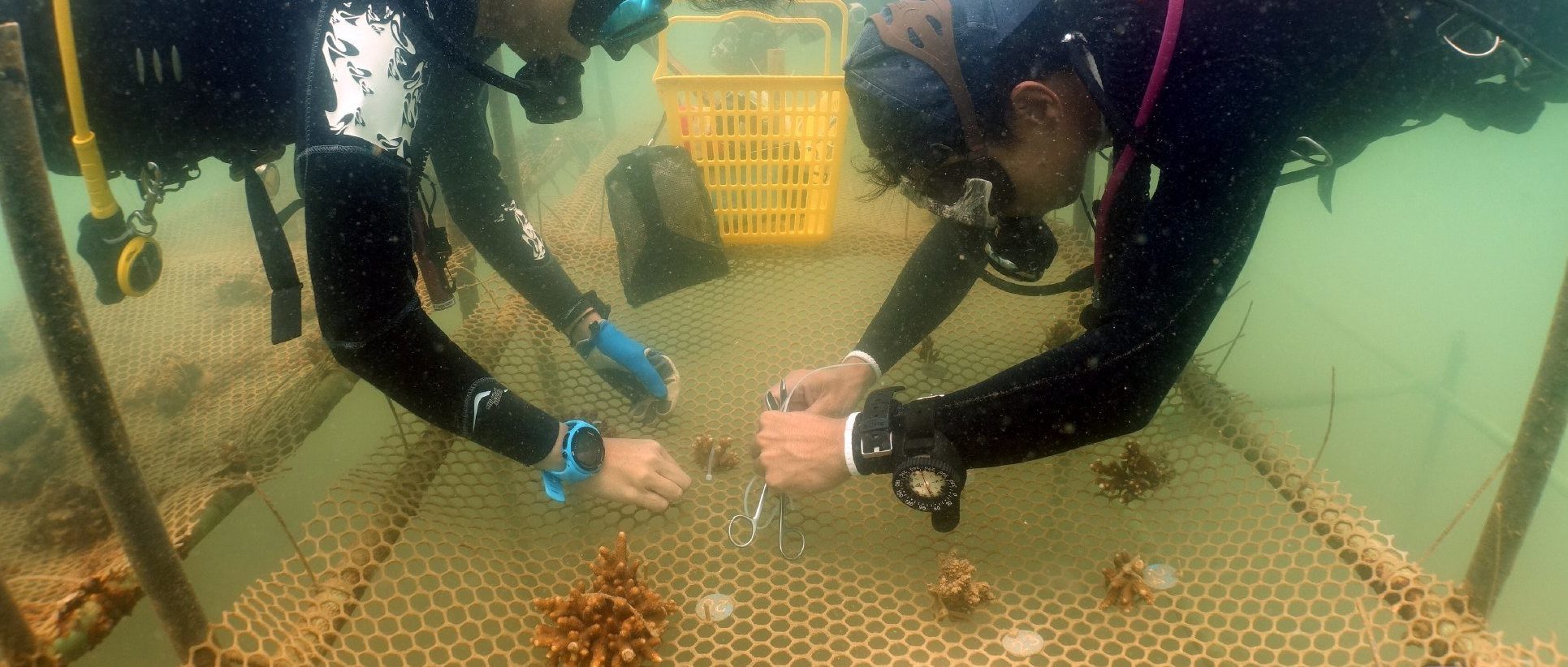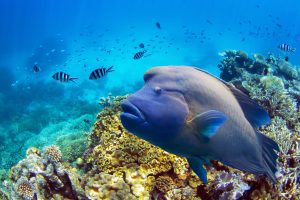Keen scuba diver Deng Lingzi regularly drives over 50 kilometres from downtown Shenzhen to Dapeng Bay to dive in waters so murky that visibility seldom extends beyond a few metres. It is very different from the clear waters teeming with coral and reef fish that made her fall in love with diving on trips to Southeast Asia.
Yet, like other volunteers with Dive for Love, a local non-governmental organisation (NGO), Deng feels it’s worth it to restore the coral reefs harmed by pollution spewing from the vast Pearl River Delta industrial zone.
Dive for Love is one of two diving projects to protect marine life in the coastal waters of the Pearl River Delta by raising public awareness of degradation from industrial pollution, overfishing and climate change.
Overfishing and coral harvesting have caused underwater desertification.
Dive for Love has been on a steep learning curve as it has experimented with the best way to restore the reef.
Choking in darkness
Corals depend on symbiotic algae, known as zooxanthellae, for oxygen and essential nutrients. The algae growing inside the coral need sunlight for survival, so warm, clear water that allows sunlight through is their ideal habitat.
Shenzhen has the opposite conditions: in 2017, official monitoring found the water quality in 53.3% of Shenzhen’s marine territory was worse than China’s national Grade IV and therefore not fit for any kind of use. The situation was particularly bad in the western part of the city where the heavily polluted Pearl River enters the South China Sea.
Although the Pearl River Delta’s manufacturing zone has been moving towards focusing on high-end manufacturing in recent years, its rivers remain heavily polluted, with 39% of the waters rated “unfit for human touch”.
Dapeng Bay in the city’s eastern outskirts, where Dive for Love works, is an exception, with water rated “good” thanks to limited industrial development.
However, overfishing and coral harvesting have caused underwater desertification. The coverage of coral on the seabed has dropped from 76% just three decades ago to 36% in 2017.
Fishing nets dumped in the sea and littering by tourists have exacerbated the damage.

Taking the plunge
Each dive requires meticulous preparation and support from the surface to protect the team from unpredictable conditions underwater, which are exacerbated by poor visibility.
In 2012, the group began by planting new corals in metal structures fixed to the seabed, using methods that have worked elsewhere.
But they have abandoned the metal frames because they were torn loose in typhoons, harming the seabed. They are now experimenting with net structures made of softer, lighter materials that can move with waves and surges and can eventually be recycled.
Nor are they planting new corals, preferring to save fragments that have dropped from the existing reef.
As Dive for Love’s general secretary Xia Jiaxiang explains, the group was “really upbeat about our achievement,” of planting 5,603 pots of coral within a few years, but it was forced into a rethink as only 43% survived being dragged during typhoons.
Deng and her teammates are monitoring the success of their new approach by photographing and documenting the 70 or so replanted coral fragments. The initial results are promising: more than 90% are still alive.
Local support for coral protection
Dive for Love has also worked hard to involve local people and educate the public.
“When we first came to Dapeng, locals were rather sceptical of our motives. They even thought we were here to grab their land,” says Xia.
Xia decided to start by inviting locals to teach the volunteers their knowledge of the sea, a move that has helped build trust between the environmentalists and the fishing community.
“They soon understood that protecting coral reefs is also in their best interests, and some even became our ‘coral watchers’ – helping to warn off those who’d cause damage to corals under our rehabilitation,” says Xia.
One fisherman explained to Xia how they would use the sticky secretions from sea cucumbers to heal cuts caused by coral. “I was amazed, because that was exactly the same thing indigenous people on Fijian islands would do,” says Xia. “I then realised that we were quickly losing such unique wisdom.”

Teaching the next generation
This discovery inspired a game-based course for primary school students. It blends local folk knowledge with scientific basics about fish, coral and conservation, and has become a hit with local schools.
According to the US National Oceanic and Atmospheric Administration, 19% of coral reefs have been lost worldwide, and a further 35% are at risk over the next 20-40 years. This is jeopardising their role in supporting one million species, including 25% of the world’s fish, and protecting against coastal erosion.
Xia knows the real impact of their coral restoration attempts could be very limited against the backdrop of a rapid wipe-out of coral reefs worldwide due to global warming, but says it is important to “pay back our debts” to nature “while we can”.
Marine survey
Dive for Love is not alone in its efforts to protect corals. Other divers recruited by a conservation NGO called BLOOM Association are spending their summer weekends cataloguing Hong Kong’s fish populations.
The aim is to create a baseline for future environmental impact assessments by policy-makers, and for further academic research.
“The project was started following the realisation that Hong Kong’s species list and existing research on marine reef fish was mostly scarce and dispersed, and also out of date,” says Stan Shea, marine programme director of BLOOM Association.
Volunteer Dr Allen To, who works as a conservationist with a major international environmental group, says “putting years of data together” will provide a database and valuable reference point but “very few research institutes would spend time and resources on this type of study, as it is easier to get funding for fancier research projects. That’s why BLOOM’s work is very important.”

Hong Kong also has the second largest per capita consumption of seafood in Asia, three times more than the global average. BLOOM wants to remind Hong Kong residents of the beauty and ecological value of marine life.
The group of 60 volunteer surveyors includes award-winning underwater photographers, marine biologists and diving enthusiasts. They have recorded close to 400 species in 50 sites since 2014.
For those who have not studied marine biology, it is a challenging task as they must memorise over 400 species of fish to identify them underwater, sometimes in very poor visibility. Rare species must be photographed, another test of underwater skill.
They have documented about ten species that are new to Hong Kong’s official records, and the researchers in the team have published findings in peer-reviewed journals.
Challenges
China now has the world’s fastest growing market for scuba diving. According to estimates by PADI, the world’s leading scuba diver training organisation, the country has about 300,000 divers.
Spear fishing is growing in popularity and divers share information on Facebook: “I felt heartbroken when I saw photos of their catch – some of the species were really rare,” says BLOOM programme officer Kathleen Ho.
Xia hopes these new divers can be persuaded to channel their enthusiasm towards marine conservation, including coral restoration. “They’ve seen the beauty with their own eyes, and could deliver this message to many more non-divers.”







![Bhutan elections 2018. Bhutanese scrutinise claims on an election board - the only place where political parties are allowed to put promotional material [image courtesy: Kuensel]](https://dialogue.earth/content/uploads/2018/10/election-2018-300x225.jpg)
![Farming the biofuel Jatropha in Morocco [Image: Joydeep Gupta]](https://dialogue.earth/content/uploads/2018/10/Jatropha_Morocco-300x225.jpg)